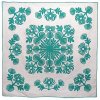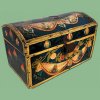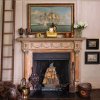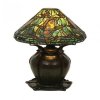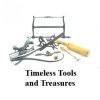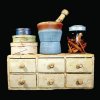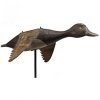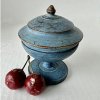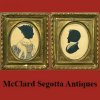The Delaware Antiques Show 2016
November 13th, 2016
Wilmington, Delaware
“The press got the election wrong, and you guys are wrong about brown furniture—it’s doing very well,” said Woodbury, Connecticut, dealer David Schorsch, who was showing for the first time at the 53rd annual Delaware Antiques Show and watching brown furniture sell like hot cakes.
No one, dealers or market watchers, expected that would happen at the Delaware Antiques Show, which opened just three days after the presidential election when many were stunned that Donald Trump had become the 45th president.
They were surprised that collectors came to the preview ready to buy a lot of brown furniture, and even more sold during the next three days, along with ceramics, textiles, maps, prints, and jewelry.
Was this spike in spending an emotional release after the nastiest election in memory, because indulgence makes disappointment go away? Did the gains in the stock market instead of the predicted plunge make people feel wealthy? Did Trump’s promise of tax cuts for the rich make them spend money not yet jingling in their jeans? Were the somewhat more reasonable prices for first-rate antiques a big incentive? Or was it the fact that that there is no sales tax in Delaware? Whatever the reason, there was a flurry of buying from the moment the show opened its doors for the crowded preview on Thursday, November 10, 2016, until the last straggler left on Sunday afternoon, November 13.

Frank Levy of Bernard and S. Dean Levy, New York City, asked $22,500 for this circa 1770 Rhode Island tiger maple desk. The signed 40" x 50½" oil on canvas painting, 1853, of Fairmount Park, Philadelphia, by Nicolino Vicomte Calyo (1799-1884) shows the Fairmount Water Works and Lemon Hill. The asking price was $135,000, and it sold.
The buyers were not just local collectors who attend educational seminars and lectures at Winterthur and were showing support for the museum. Winterthur’s educational program was the beneficiary of the show. Buyers were from Texas, Tennessee, Indiana, Ohio, Virginia, and Washington, D.C., as well as day-trippers from Maryland, Pennsylvania, and New Jersey, according to dealers who made multiple sales. Members of the Henry Francis du Pont Collectors Circle gathered for four days of lectures, lunches, dinners, and visits to collections with time to visit the show each day, which encouraged this well-heeled group to make purchases.
 Moments after the show opened, Downingtown, Pennsylvania, dealer Philip Bradley sold a set of six Queen Anne chairs made in the 1740s for the Scattergood family who lived in New Jersey just across the Delaware River from Philadelphia. During the first hour, West Chester, Pennsylvania, dealer Skip Chalfant sold a chest-on-chest signed “Claypoole,” a Philadelphia comb-back Windsor chair, and a tall-case clock by John Wood Sr.—all to the same buyer.
Moments after the show opened, Downingtown, Pennsylvania, dealer Philip Bradley sold a set of six Queen Anne chairs made in the 1740s for the Scattergood family who lived in New Jersey just across the Delaware River from Philadelphia. During the first hour, West Chester, Pennsylvania, dealer Skip Chalfant sold a chest-on-chest signed “Claypoole,” a Philadelphia comb-back Windsor chair, and a tall-case clock by John Wood Sr.—all to the same buyer.
“A sale like this hasn’t happened since the bottom fell out of this the market in 2008,” said John Welch, who helps Chalfant at shows.

Stephen-Douglas Antiques, Rockingham, Vermont, asked $12,500 for this painted chest. The bowl of wooden fruit was $14,500; the fire buckets made for “A Wendell” in Portsmouth, New Hampshire, were $23,500 the pair. The cornucopia was $3800, and the pair of carved birds, $3600. The cornucopia sold.
Chalfant was not the only dealer to sell brown furniture. Before the preview was over, Gary Sullivan of Canton, Massachusetts, had sold a pair of Duncan Phyfe footstools; Christopher H. Jones of Alexandria, Virginia, sold a pair of Federal shield-back chairs made in Baltimore; and Frank Levy of New York City sold a convex mirror. James Price of Carlisle, Pennsylvania, sold a dower chest with sulfur inlay, and Joe Kindig of Lancaster, Pennsylvania, sold an early sawbuck table of walnut, one of three known that have shaped legs. That was just the beginning. On Friday Kelly Kinzle of New Oxford, Pennsylvania, sold a painted schrank made for Charming Forge in the 1750s when Henry William Stiegel owned it. It was the only major piece of painted furniture that sold at the show.
A couple from Maryland found their perfect corner cupboard with a salmon-red interior, offered by Philip Bradley. Christopher Jones also sold a worktable, and James Price sold a walnut schrank. By Saturday Price had sold a Federal inlaid tall-case clock with a rare eagle inlay and eight-day movement by Jacob Eby, Manheim, Pennsylvania; a Philadelphia drop-leaf dining table with ball-and-claw feet; a Wilmington, Delaware, Windsor chair by Jared Chestnut; and more.

This rare William and Mary period ball-footed desk-and-bookcase with a double-dome top was one of the most talked-about pieces at the show. Its small size (82" high x 36" wide case) and unusual design with intricate columnar inlays suggest that it was made by a cabinetmaker who likely arrived from England just before it was made sometime between 1710 and 1720. It is made of American black walnut with clear white pine as the secondary wood. Peter Eaton of Newbury, Massachusetts, asked $110,000. Eaton sold it in 1990 and recently purchased it back. There is museum interest in it, and collectors are on the list if the museum purchase is not approved. Eaton sold seven pieces of furniture.
Peter Eaton of Newbury, Massachusetts, sold a ladder-back armchair, a large refectory tavern table, a New England balloon-seat side chair, a New England candlestand, and more. Christopher Rebollo of Lahaska, Pennsylvania, found a buyer for his Philadelphia camelback sofa, a pair of Philadelphia side chairs attributed to John Affleck, and a previously unknown rococo high chest of drawers.
Sumpter Priddy of Alexandria, Virginia, had an “institutional hold” on his sofa from the Shenandoah Valley with dramatic swept-back arms; two collectors are in line for it if the museum does not buy it. Frank Levy sold a fine Philadelphia dressing table that had a $175,000 tag. It was fresh to the market. Some of what sold had been offered at other shows.
Whatever their politics, buyers bought items that expressed their patriotism. One new buyer bought three Liverpool jugs with patriotic transfers from Jesse Goldberg of Artemis Gallery, North Salem, New York, and began a new collection. Ralph and Gretchen Franzese of Pittstown, New Jersey, sold a pair of large metal eagles.

The child’s poplar blanket chest decorated by an unknown artist noted for his squiggly or scraggly decorations, circa 1800, with two floral panels and two drawers, one of only five painted chests known of this size (19" x 27"), was $64,000 from Skip Chalfant of West Chester, Pennsylvania. The full-size Berks County painted blanket chest, circa 1800, was $24,000.
Decorations of all sorts found buyers. Collector Marjorie McGraw said she bought large shellwork vases with flowers from Diana Bittel and an early beadwork picture from Joe Kindig. “Joe said it was the best picture of this kind he had ever sold,” she said. And after a few days’ consideration, she bought a large hooked rug with three leopards on it from James Wm. Lowery of Baldwinsville, New York.
Ceramics dealers A.J. Warren of Sandy Hook, Connecticut, and Martyn Edgell from Cambridgeshire, England, sold creamware, slipware, and Prattware. Polly Latham of Boston was busy selling Chinese export porcelain to collectors and sold three pieces to a group of young Chinese customers. Chinese buyers shopping on Sunday left with packages. The Mellin’s Antiques stand was filled with shoppers on Friday morning, all wanting blue and white Canton. They bought salad bowls, cider jugs, coffeepots, pots de crème, a cache pot, and more. Ralph M. Chait Galleries, New York City, said its sales of Kangxi Chinese porcelain, made for the Chinese and not for export, were to American collectors.

The southeastern Pennsylvania splayed-leg tavern table with flat stretchers was $175,000; the Philadelphia comb-back armchair was $55,000. The embroidered and appliquéd memory quilt, dated 1900-12, probably made in Virginia, 77" x 57", with 108 squares commemorating family life, was $14,000, all from James and Nancy Glazer of Bailey Island, Maine.
Lori Cohen of Arader Galleries, Philadelphia and New York City, showing at Delaware for the first time, said she sold two maps and six natural history prints on preview night and by Sunday had sold a collection of prints of fishes, a Catesby print, a pair of botanical prints by Maria Sibylla Merian, a Fisher map of New England, and some small maps of Delaware.
Collectors bought needlework and printed textiles. “Knowledgeable collectors who have been on the sidelines are buying again because they see that prices are down to a level they can afford,” said Jesse Goldberg of Artemis Gallery.

The hooked rug of leopards got a lot of attention. Found in Scriba, New York, it was made 1860-80. It was $89,000 from James Wm. Lowery of Baldwinsville, New York, and sold to collector Marjorie McGraw.
Will this surge in buying continue? One way to give it a boost might be to get Melania Trump to leave her gilt furniture in New York and furnish the private quarters in the White House with Americana. She could start with Barron’s room and buy the Ipswich, Massachusetts, shell-carved bonnet-top high chest from Frank Levy, the soaring tall-case clock by Thomas Wagstaff, London, in a rococo Philadelphia case with a bird on top from Gary Sullivan, a small wing chair covered in blue wool from David Schorsch, just Barron’s size, and the folding campaign chair from Philip Bradley that could have been used during the War of 1812. The Lancaster County blanket chest on the Kindig stand with shoe feet, inlaid with stars and the initials “EH,” could go at the foot of his bed to hide a lot of stuff when he needs to clean up his room. Why not hang historic maps on the wall from Arader Galleries or the Philadelphia Print Shop, or Mark Allen’s 1715 Moll map of North America that needed a frame? There might be wall space for the painting at Robert Schwarz’s stand of a $20 bill by John Frederick Peto painted in 1889. It is one of only four similar paintings by Peto because the treasury department put a stop to painted depictions of money, afraid the trompe l’oeil paintings fostered counterfeiting. That painting might remind Barron that his father is wrestling with monetary policy, tax reform, and the politics of minimum wage.

Hilary Nolan of Falmouth, Massachusetts, asked $23,000 for this ship captain’s or bursar’s filing cabinet. From the 18th century and possibly made on an island, it has large original carrying handles on the sides of the top and bottom and the names of destinations on the drawers, such as Jamaica, Gold Coast, Philadelphia, and North Carolina.
Melania’s decorator may have missed the Delaware show, but the Winter Antiques Show and Americana Week auctions and shows are on the New York January calendar, just days before the inauguration. If catalogs are sent to the Trumps, along with tickets to the show, perhaps, like the Kennedys in the 1960s, they can energize another bull market for Americana. Is that too much to wish?
For more information, go to (www.winterthur.org/das).

Ralph and Gretchen Franzese of R.G.L. Antiques, Pittstown, New Jersey, came to the show at the last moment when Butch Berdan of Jewett-Berdan Antiques had gall bladder surgery and had to cancel. They offered a broad selection of 19th-century glass and some folk art. On the top shelf, left, is one of three known examples of the first Pittsburgh pillar-molded bar bottles with cobalt blue stripes; it was $28,000. The dome-lidded sugar bowl, New England or Midwest, circa 1820, was priced at $12,500. The Amelung checkered diamond blue glass salt made in Maryland was $8500. The rare amber Ohio ribbed salt, circa 1800, was $6500. On the right is a very rare J.E. Caldwell engraved trophy, signed on the bottom, for $18,500. On the bottom row the pair of amethyst Boston Sandwich bar bottles was priced at $975 the pair. The pair of clear glass decanters with blue glass bands, circa 1850, was $1900 the pair; the extremely rare cobalt-blue pillar-molded Sandwich or Pittsburgh vase, circa 1850, was $5800.
Originally published in the January 2017 issue of Maine Antique Digest. © 2016 Maine Antique Digest

